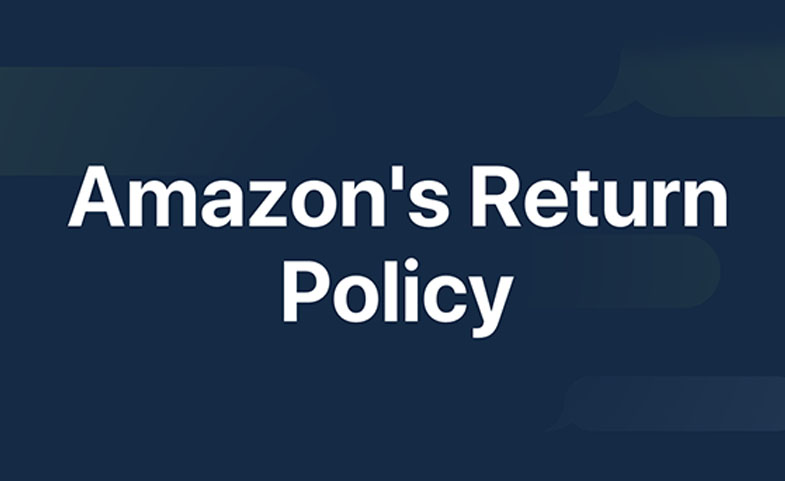In the vast e-commerce landscape, Amazon stands as a titan, revolutionizing the way we shop online. One key aspect that has contributed to its success is the customer-centric approach, epitomized by its return policy. While this policy is undoubtedly beneficial for buyers, it also has profound implications for sellers.
What Is Amazon's Return Policy?
Amazon's return policy serves as a crucial linchpin, catering to both customers and sellers. This policy, designed to prioritize buyer satisfaction, undoubtedly shapes the seller experience in multifaceted ways. The policy generally allows customers to return most items within 30 days of receipt, fostering a customer-centric environment. However, certain product categories, like FBA baby items and Birthday Gift Lists, enjoy an extended returns timeframe of 90 days.
Items that cannot be returned
Not all items are eligible for returns. Perishables, personalized items, digital content, and more fall into this category. The exclusion list also includes hazardous materials, specific health and personal care orders, and even live insects. These exclusions create a dynamic landscape for sellers, necessitating careful consideration of the types of products they offer.
How Does Amazon Return Process Work?
The return process on Amazon typically involves buyers initiating returns within 30 days of receiving the item. Amazon's A-Z Guarantee ensures protection for customers, emphasizing quality control for sellers. Fulfillment by Amazon (FBA) sellers experience automated return processing, while Fulfillment by Merchant (FBM) sellers need to manage returns in accordance with Amazon's policies.
What Is Amazon FBA Returns Policy for Sellers?
For sellers using Amazon's Fulfilled by Amazon (FBA) program, the return process is a bit like a magic trick – Amazon takes care of it behind the scenes. Here's the lowdown:
- No Control Over Returns: As an FBA seller, you don't get to decide whether to accept or decline a return. Amazon handles this for you.
- Refunds First, Inspections Later: Amazon often refunds buyers right away, inspecting the returned item later to check its condition. This quick refund process can sometimes catch sellers off guard.
What happens to the items customers send back to FBA sellers?
Item is Sellable
- If the returned item is in good condition and can be sold again, Amazon puts it back in your inventory. You get a partial refund for the referral fee, and in some cases, Amazon covers variable closing fees.
Item is Unsellable (Amazon's Fault)
- If the product is unsellable due to Amazon's handling, you need to request a removal order. Amazon credits you for the product's selling price, part of the referral fees, and any taxes incurred.
Item is Damaged (Seller's Fault)
- In the unfortunate event that the item is damaged, it becomes "Unfulfillable." You initiate a removal order, and Amazon credits your account for all or part of the referral fee and variable closing fee (if applicable).
What If the Buyer Doesn't Return the Product?
- If the buyer doesn't send the product back within 45 days of initiating the return, Amazon steps in.
- Amazon will recharge the buyer if they've already been refunded and reimburses the seller.
- If this reimbursement doesn't happen, sellers should open a support case to rectify the situation.
What to do with the returned inventory?
When the returned product reaches the fulfillment center and Amazon deems it sellable, sellers have choices.
a. Attempt to Sell Again:
- If the product is marked as sellable, sellers can try listing it again for sale.
- There's a risk if the item is damaged, leading to potential negative feedback when someone else buys it.
b. Utilize FBA Liquidations:
- Sellers can opt for the FBA Liquidations program through Seller Central.
- By filing a liquidation request, Amazon evaluates the average selling price, and sellers can get around 5% to 10% of it from wholesale liquidators within 60 days.
c. Explore FBA Grade and Resell:
- The FBA Grade and Resell program allow sellers to relist unfulfillable returned inventory as used items.
- Amazon assigns appropriate conditions (Like New, Very Good, Good, or Acceptable) and creates a new listing.
d. Embrace FBA Donations:
- Amazon's FBA Donations program enables sellers to donate inventory to US charities through a partnership with Good360.
- This option helps avoid removal and disposal fees, providing a philanthropic angle to dealing with excess inventory.
What Is Amazon FBM Seller Returns Policy?
- If you are an FBM seller, your returns policy works differently from FBA. Amazon requires that FBM sellers match or exceed Amazon's return policy, which means they must accept returns within 30 days of receipt, regardless of the reason.
- Returns are sent back to the address you specified, and you must refund the customer within 2 days of receiving the return.
- If you are a professional seller, you will be automatically enrolled in the Amazon Prepaid Returns Label program. With it, Amazon sends the buyer a prepaid return shipping label on your behalf.
- That doesn’t allow you to contact the customer and settle the issue before they are automatically refunded. If you are an individual seller, you may apply for enrollment in the program.
Effects of Amazon's return policy on sellers
The Customer-Centric Philosophy:
- Amazon's return policy is designed to prioritize the customer experience, fostering trust and loyalty. With features like easy returns, prepaid shipping labels, and a generous return window, Amazon has set a gold standard for customer service.
- While this undoubtedly enhances the shopping experience, it creates a dynamic environment for sellers, where returns become an integral part of the business landscape.
Impact on Seller Profitability:
- For sellers on Amazon, returns can be a double-edged sword. On one hand, the customer-friendly policy attracts more buyers, boosting sales.
- However, the flip side is the potential for increased return rates, impacting the bottom line.
- Frequent returns can erode profits, especially for small and medium-sized businesses that may lack the resources to absorb the associated costs.
Operational Challenges:
- Managing returns efficiently poses a significant operational challenge for sellers. From restocking returned items to dealing with damaged goods, the logistics of handling returns can be intricate and time-consuming.
- Sellers must establish robust processes to streamline these operations, minimizing the impact on their day-to-day business activities.
The A-Z Guarantee and Seller Accountability:
- Amazon's A-Z Guarantee ensures that customers are protected if they receive damaged or defective items, or if the product doesn't match the listing.
- While this guarantee fosters trust, it also holds sellers accountable for the quality of their products.
- Sellers need to uphold stringent quality control measures to avoid the financial repercussions of refunding customers through the A-Z Guarantee.
Conclusion:
Amazon's customer-centric return policy has undoubtedly shaped the e-commerce landscape, creating a marketplace where customer satisfaction is paramount. For sellers, adapting to this environment requires a nuanced approach that balances customer service with operational efficiency. By understanding the intricacies of Amazon's return policy and implementing proactive strategies, sellers can not only survive but thrive in this dynamic marketplace. As the e-commerce landscape continues to evolve, the symbiotic relationship between buyers and sellers on Amazon will play a pivotal role in shaping the future of online retail.


